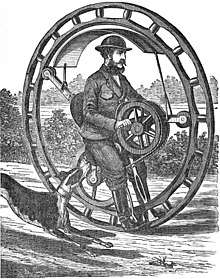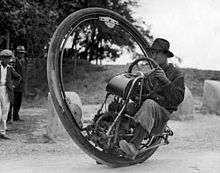Monowheel
A monowheel is a one-wheeled single-track vehicle similar to a unicycle. Instead of sitting above the wheel as in a unicycle, the rider sits either within the wheel or next to it. The wheel is a ring, usually driven by smaller wheels pressing against its inner rim. Most are single-passenger vehicles, though multi-passenger models have been built.


Hand-cranked[2] and pedal-powered monowheels were patented[3] and built in the late 19th century; most built in the 20th century have been motorized. Some modern builders refer to these vehicles as monocycles, though that term is also sometimes used to describe motorized unicycles.
Today, monowheels are generally built and used for fun and entertainment purposes, though from the 1860s through to the 1930s, they were proposed for use as serious transportation.
The world speed record for a motorized monowheel is 98.464 km/h (61.18 mph).[4]
Steering
In a two-wheel mode of transportation, two systems (wheels) affect motion. Typically one wheel provides the force to control speed, while the other handles changes in direction: steering. For a monowheel, both direction and speed are controlled through the same physical apparatus; this generally makes steering more difficult. In a majority of systems, change in direction is effected by the rider shifting their weight, or in the sudden movement creating a shearing force between a handhold and the axis that the driver is settled on. Better control can usually be achieved at lower speeds. Because of the steering problem, monowheels have never caught on as a widely accepted mode of transportation.
A change in direction can be effected in several ways including:
- Leaning. The most common steering solution is that the rider must lean towards their intended direction of travel to turn, and then centralize their weight again once the turn is complete.
- Turning a gyroscope to provide turning force.
- Outboard skids to provide friction drag on one side.
- At speeds faster than a walk, lightly dragging a foot on the ground will cause the wheel to lean to the opposite side. Drag the other foot to bring it back upright.
- Small wheels used for steering, either one to each side or a single unit either in front of or behind the vehicle. It is a matter of debate as to whether such a vehicle would still properly be called a monowheel.
- Steerable propellers, which could provide both steering and power to move the vehicle. It has been noted that having a propeller operating near pedestrians could be quite unsafe.
- Steerable tail surfaces, similar to those on airplanes. This solution would not work at low speeds.
Other issues
- Limited horizontal stability. A single wheel can fall over, unless it is quite wide or has some form of active stabilization, such as a gyroscope. Some designs have used outrigger skids or small wheels to address this. In many one-person designs, being at a stop requires the driver to put their feet on the ground, the same way as on a motorcycle.
- Limited capacity. Monowheels tend to be larger than a car of similar carrying capacity. Most have been kept small by being built to carry only one rider and with little or no space for baggage.
- Risk of "gerbiling". In most designs, if the driver accelerates or brakes too hard, it is possible that the force applied overcomes the force of gravity keeping the rider at the bottom of the wheel, sending the rider spinning around the inside of the wheel. This is known as gerbiling because it has some similarity to the situation of a gerbil running too quickly inside of a hamster wheel.
- Visibility issues. In driver-inside designs, the rider is always facing the inner rim of the wheel, which can obstruct the view of oncoming hazards from all angles.
Variants and related vehicles
There have been many proposals for variants or uses, such as a horse-drawn monowheel or a monowheel tank. A variant was proposed that placed two riders outside of the wheel itself, with one person on each side to provide for balance.
An electric monowheel called Dynasphere was tested in 1932 in the United Kingdom.
One variant called a RIOT wheel was presented at Burning Man in 2003. It involves the passengers sitting in front of the wheel and being balanced by a heavy counterweight inside the wheel. Rather than the typical ring drive, this vehicle is powered through a sprocket attached to the spokes.
A company in the Netherlands began taking custom orders of a monocycle configured variant called the Wheelsurf in 2007.
A related vehicle is the diwheel or the dicycle, in which the rider is suspended between or inside of a pair of large wheels placed side by side. An example of this would be the character Axel from the Twisted Metal series of video games published by Sony.
In 1971, an American inventor named Kerry McLean built his first monocycle (aka monowheel). In 2000, he built a larger version, the McLean Rocket Roadster powered by a Buick V-8 engine, which subsequently crashed in 2001 during the initial test run. McLean survived and proceeded to build over 25 different variations of his version of the monocycle, from pedal powered models, 5HP models, all the way up to V8 powered models.
In 2010, Nokia utilized two of McLean's monocycles in their commercials promoting the new Nokia SatNav smartphone.
In McLean's latest creation, the 2011 McLean V8 Drag Wheel, the wheel itself was machined out of a single piece of high-strength aircraft grade aluminum billet.
See also
- Cyr wheel
- Dynasphere
- Hubless wheel
- Outline of cycling
- Self-balancing unicycle
- Uno (dicycle)
- Kugelpanzer - monowheel tank
- Monowheel tractor
References
- "Improvement in velocipede: US 92528 A". Google India. Retrieved July 21, 2016.
- Goddard, J. T. (1869). The velocipede: its history, varieties, and practice. University of Princeton: Hurd and Houghton. pp. 76–78.
- US 325548, J.O. Lose, "One wheeled vehicle", issued 1 September 1885
- "Guinness World Record for bearded woman Harnaam Kaur". BBC News. Retrieved 8 September 2016.
External links
| Wikimedia Commons has media related to Monowheels. |
- Video of Guinness world speed record
- Channel 4's Scrapheap Challenge page on the Monowheel
- Monovelo, the 2008 Beijing Olympic Games Monowheel
- "Speedy New Motor-Hoop Amazes Italians", Popular Science, December 1924, page 40, scanned by Google Books
- "Amazing New Motor-Driven Hoop May Be Car of the Future", Popular Science, May 1932, front cover and page 63, scanned by Google Books
- "War Tank on One Wheel, Operated by One Man", Popular Science, November 1933, front cover and page 47, scanned by Google Books
- Cycle World: Circle Cycle
- Impact Lab: History of the World’s Craziest Invention - The Monowheel
- Douglas Self's monowheel page